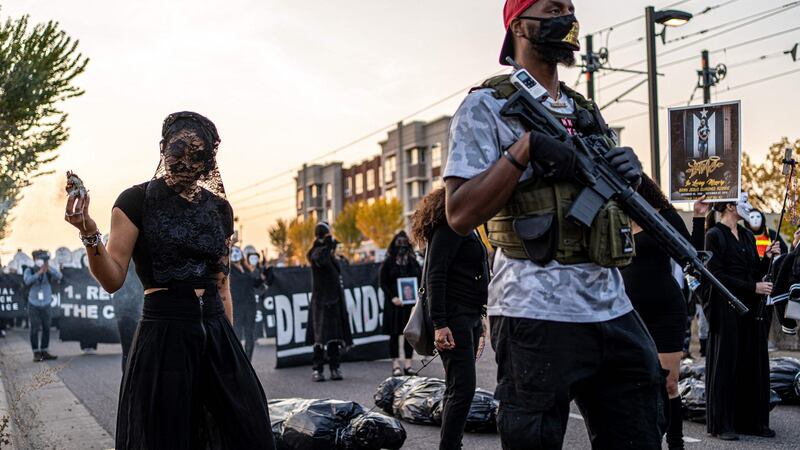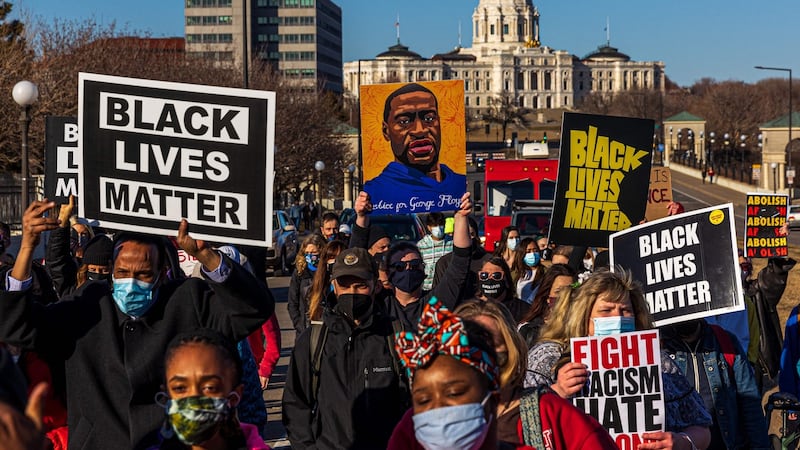The graphic video of George Floyd's killing was the catalyst for global protests against racism in policing. Whether it will be enough to persuade a jury in Minneapolis to convict the police officer shown kneeling on his neck is a more difficult question.
It is rare for a US police officer to face criminal charges for misconduct. In that respect, the case brought against Derek Chauvin – the police officer who pressed his knee into the black man's neck for nearly nine minutes while he called for his mother and struggled to breathe – is an encouraging sign for activists hoping to increase police accountability.
Nevertheless, experts say that securing a conviction will be a struggle, given the legal hurdles that have traditionally stood in the way of similar cases and the inherent trust many Americans have in the police.
When he took over the prosecution last year, Minnesota attorney general Keith Ellison warned that obtaining a conviction would be hard, "not because we doubt our resources or our ability ... but history does show there are clear challenges here".
Opening statements in the trial are set to begin on Monday, and the proceedings will be broadcast online in an unusual move triggered by the coronavirus pandemic and intense attention on the case.
The footage of Floyd’s death will be just one of many pieces of evidence that the jury will be allowed to consider before they give their verdict on Chauvin, a decision that could add more fuel to the volatile debate around race and policing.
Prosecutors have hedged their bets by pursuing three charges: second- and third-degree murder and manslaughter. The most serious, second-degree murder, requires that prosecutors prove Chauvin unintentionally killed Floyd while committing a felony. Manslaughter requires only proving Chauvin took an unreasonable risk of causing death.
Manslaughter carries a maximum prison sentence of 10 years, compared to 40 years for second-degree murder.
Without the publicity generated by the video, Chauvin and the others might not have lost their jobs – a fact that could tarnish their credibility with the jury, said Jeannine Bell, a professor at Indiana University's law school who studies policing.
Ingrained trust
Yet video footage has not always resulted in guilty verdicts in similar trials. The case against Michael Slager, a South Carolina police officer who was filmed shooting a man in the back, ended in a mistrial. Eventually, he pleaded guilty to a federal charge of violating the civil rights of Walter Scott.
In the 2017 trial of Jeronimo Yanez, a suburban Minneapolis officer who killed school cafeteria worker Philando Castile, jurors watched footage of the shooting's immediate aftermath that Castile's partner had livestreamed.
An ingrained trust in law enforcement can make it difficult to secure convictions against police officers, Bell said. “People believe police,” she said. “The stats are that people who sit on juries trust the police, so they’re more likely to believe the police, and what police say, than what witnesses say.”
Jurors’ trust in police also colours how they see other evidence. The Hennepin County medical examiner’s post mortem examination last year put the cause of Floyd’s death as “cardiopulmonary arrest complicating law enforcement subdual, restraint and neck compression”, and found evidence of fentanyl and methamphetamine in his body. An independent post mortem commissioned by Floyd’s family cited the cause of death as asphyxiation.

Judge Peter Cahill also has allowed Chauvin's defence team to tell the jury about some parts of a May 6th, 2019 traffic stop, where there was evidence Floyd swallowed drugs after police approached him.
Jurors might be “more likely to see [Chauvin’s actions] as a reasonable use of force”, because racial bias associates black men with violence and criminality, Bell said.
But video also makes the defence's job harder, said Dan Herbert, the attorney who represented former Chicago police officer Jason Van Dyke, who was convicted of murder in 2018. Chauvin's lawyer, Eric Nelson, would need to give jurors "an out", a reason they "can look past that very powerful and compelling piece of evidence".
“The biggest argument they will make is the causation aspect of the murder charges,” he said. “If they can poke enough holes in the prosecutors’ evidence that Chauvin was responsible for the death ... that’s probably what they’re going to spend most of their time focusing on.”
Deep divisions
US police officers are infrequently charged, let alone convicted. Unofficial tallies of police shootings kept by news organisations and researchers find that police now shoot and kill nearly 1,000 people a year in the US. (Adjusted for population size, US police kill people 64 times more often than police in the UK.)
Between 2005 and 2019, 104 officers were arrested and charged with murder or manslaughter for an on-duty shooting, according to the Police Integrity Research Group at Bowling Green State University in Ohio. Thirty-five were convicted.

Public polling has suggested there are deep divisions over how Floyd’s death is perceived, and how those views have evolved since last summer.
A USAToday/Ipsos poll last June showed 60 per cent of Americans viewed Floyd's death as murder, but that fell to just 36 per cent earlier this month. Divisions along racial lines were stark: 64 per cent of black respondents thought it was murder, versus just 28 per cent of whites, who were more likely than blacks to see Chauvin's actions as negligence.
The decision on whether Chauvin committed a crime, or, as his defence team is expected to argue, that Floyd’s death resulted from drug use, will be in the jury’s hands.
After a lengthy vetting process, 15 people have been selected: 12 to serve, plus two alternates and one to be dismissed on March 29th if the others show up. There are three black men, one black woman, two mixed-race women, and nine white people.
Prosecutors in the Chauvin trial could benefit from the jury's racial diversity. White jurors might not understand the prevalence of police misconduct, said Nicole Gonzalez Van Cleve, a sociologist at Brown University who authored Crook County: Racism and Injustice in America's Largest Criminal Court.
Yet Van Cleve said unsympathetic details about a victim, particularly when that impression was rooted in racism or disdain for addiction, should not derail accountability for police.
“Nobody is above the law, and nobody deserves a death sentence without going to court,” she said. “This is a type of policing that needs to stop in America, regardless of whether the victim is sympathetic or not.”
Background: Killings that have fuelled the Black Lives Matter movement

February 26th, 2012
A black teenager, Trayvon Martin, was shot and killed in Sanford, Florida, while walking home from a convenience store. Neighbourhood watch captain George Zimmerman said he acted in self-defence. A month later, then president Barack Obama called for a full investigation, adding that, "if I had a son, he'd look like Trayvon".
July 13th, 2013
A Florida jury acquitted George Zimmerman of murder and manslaughter. Activist Alicia Garza wrote a Facebook post containing the phrase "black lives matter". Garza and activists Patrisse Cullors and Opal Tometi turned the phrase into a social media hashtag, which evolved to become the name for the burgeoning movement.
July 17th, 2014
New York police officer Daniel Pantaleo placed Eric Garner in a chokehold, a banned restraint position. Garner's dying words, "I can't breathe", filmed by a bystander, become a rallying cry for Black Lives Matter organisers. Pantaleo was not charged with a crime.
August 9th, 2014
In Ferguson, Missouri, police officer Darren Wilson shot and killed teenager Michael Brown following an altercation, saying he feared for his life. The shooting set off weeks of unrest, with peaceful protests sometimes accompanied by fires and looting, while police used tear gas and rubber bullets on crowds. Protesters took to the streets again in November when a grand jury decided no charges would be filed against Wilson. The US Department of Justice later found a pattern of discrimination against African-Americans by Ferguson police.
October 20th, 2014
Police officer Jason Van Dyke shot Chicago teenager Laquan McDonald 16 times. The killing was captured on video, which sparked protests when, more than a year later, a court forced mayor Rahm Emanuel’s police department to release the footage. In 2018, a Chicago jury convicted Van Dyke of second-degree murder – the first officer in the city convicted for an on-duty killing in decades. He was later sentenced to nearly seven years in prison.
July 6th, 2016
In suburban Minneapolis, police officer Jeronimo Yanez shot and killed Philando Castile during a traffic stop. A jury acquitted Yanez of second-degree manslaughter and two counts of dangerous discharge of a firearm 11 months later.
March 13th, 2020
Louisville, Kentucky police officers shot and killed Breonna Taylor at her home after executing a "no knock" search warrant. The city paid $12 million to settle a lawsuit over her death. Detective Brett Hankison, who fired into different apartments, is the only officer to face criminal charges in connection with her death – three counts of wanton endangerment.
May 25th, 2020
Minneapolis police officer Derek Chauvin knelt on the neck of George Floyd for nearly nine minutes while three accompanying police officers did not intervene. After a bystander posted the video online, the city erupted in protests and riots, which spread around the world. – Copyright The Financial Times Limited 2021












